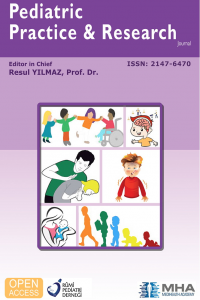Determination of Reference Intervals For Dihydrorhodamine 123 (DHR) Assay in Healthy Children
Determination of Reference Intervals For Dihydrorhodamine 123 (DHR) Assay in Healthy Children
___
- References 1. Dimitrova G, Bunkall C, Lim D, Kendrick . Comparison of two methods for the diagnosis of chronic granulomatous disease – neutrophil oxidative burst measured by the nitroblue tetrazolium slide test versus the dihydrorhodamine 123 flow cytometric assay. N Z J Med Lab Sci 2013; 67: 45-51. 2. Jirapongsananuruk O, Malech HL, Kuhns DB, et al. Diagnostic paradigm for evaluation of male patients with chronic granulomatous disease, based on dihydrorhodamine 123 assay. J Allergy Clin Immunol 2003; 111:374-9. 3. Segal BH, Leto TL, Gallin JI, Malech HL, Holland SM. Genetic, biochemical, and clinical features of chronic granulomatous disease. Medicine 2000; 79:170-200. 4. Kilic SS, Ozel M, Hafizoglu D, Karaca NE, Aksu G, Kutukculer N. The prevalances (correction) and patient characteristics of primary immunodeficiency diseases in Turkey-two centers study. J Clin Immunol 2013; 33(1):74-83. 5. Emmendorffer A, Nakamura M, Rothe G, Spiekermann K, Lohmann-Matthes ML, Roessler J. Evaluation of flow cytometric methods for diagnosis of chronic granulomatous disease variants under routine laboratory conditions. Cytometry 1994; 18:147-55. 6. Vowells SJ, Fleisher TA, Sekhsaria S, Alling DW, Maguire TE, Malech HL. Genotype-dependent variability in flow cytometric evaluation of reduced nicotinamide adenine dinucleotide phosphate oxidase function in patients with chronic granulomatous disease. J Pediatr 1996; 128:104-7. 7. Koker MY, Sanal O, Leeuwen K, et al. Four different NCF2 mutations in six families from Turkey and overview of NCF2 gene mutations. Eur J Clin Invest 2009; 39(10):942-51. 8. Köker MY. Kronik granulomatoz hastalık ve alt gruplarının tanısında DHR 123 testi ve anti-NADPH oksidaz komponent antikorlarla akım sitometrik analizin yeri. 2006. Doktora tezi, Hacettepe Üniversitesi Sağlık Bilimleri Enstitüsü, Ankara. 9. Çiçekkökü D, Öğülür Ö, Karakoç-Aydıner E et al. Oxidative Burst with Dihydrorhodamine Test: Reference Values in Healthy Controls. Turk J Immunol 2015; 3(2):49-53. 10. Bonilla FA, Bernstein IL, Khan DA et al. Practice parameter for the diagnosis and management of primary immunodeficiency. J Allergy Clin Immunol. 2015; 136:1186-205. 11. Bousfiha A, Jeddane L, Picard C et al. The 2017 IUIS Phenotypic Classification for Primary Immunodeficiencies. J Clin Immunol 2018; 38(1):129-43. 12. Kulkarni M, Gupta M, Madkaikar M. Phenotypic Prenatal Diagnosis of Chronic Granulomatous Disease: A Useful Tool in The Absence Of Molecular Diagnosis. Scand J Immunol 2017; 86(6):486-490. 13. Koker MY, Camcıoglu Y, Leeuwen K, et al. Clinical, functional, and genetic characterization of chronic granulomatous diseases in 89 Turkish patients. J Allergy Clin Immunol 2013; 132:1156-63.
- ISSN: 2147-6470
- Başlangıç: 2013
- Yayıncı: MediHealth Academy Yayıncılık
Büşra Zeynep YILMAZ, Nazife BÜYÜKCAVLAK, Bülent ATAŞ
Trombosit Transfüzyonunda Trombosit Sayısı ile Trombosit Kitlesi Kullanımının Karşılaştırılması
Ahmet ÖKTEM, Ahmet ÖZYAZICI, Ayşegül ZENCİROĞLU
Saime Sundus UYGUN, Haluk YAVUZ
Ahmet Emre HATIR, Sevgi PEKCAN
Investi̇Gation of Serum Vitamin D Levels in Term Newborns and Their Mothers
Pediatric Headache: A Single Center Experience
Hatice YILMAZ DAĞLI, Sevgi PEKCAN, İsmail REİSLİ, Sevgi KELEŞ
